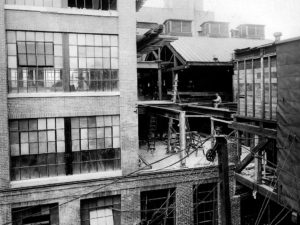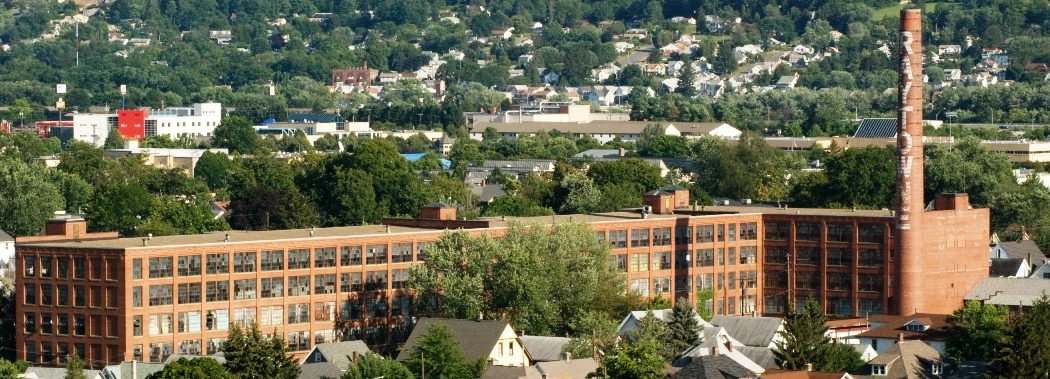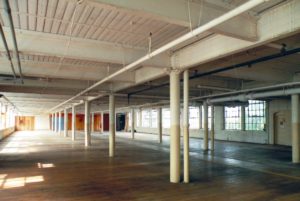Several years ago, the Pajama Factory was a nearly abandoned 300,000 sft historic mill building in the center of Williamsport, Pennsylvania, a small rustbelt city that has seen more than its fair share of population and economic decline.
 Now, the historic complex is being repurposed and renovated into a mix of cultural amenities, commercial space, artist studios, and residences.
Now, the historic complex is being repurposed and renovated into a mix of cultural amenities, commercial space, artist studios, and residences.
On November 1, 2018, the Council of Development Finance Agencies (CDFA) has released a Roadmap to Redevelopment report for the Pajama Factory, following a site visit in August of 2018.
The report provides financing strategies to accelerate the redevelopment of an eight-building complex into a creative community featuring artist residences and work studios, retail opportunities, and event space.
The factory was built in phases between 1883 and 1919 by the Lycoming Rubber Company, a subsidiary of the U.S. Rubber Company, which was one of the largest manufacturers of rubber goods in the U.S. at the time. The Lycoming division made tennis shoes, gym and yachting shoes, as well as some miscellaneous rubber related products.
After 1932, the Rubber Company moved out, due to a decline in product demand. The Weldon Pajama Company leased the space in the building beginning in 1934 and purchased the entire complex in 1951. It became one of the largest pajama factories in the world and until 1979, various companies utilized the space including pajama, underwear, and shoe manufacturers.
Since the factory closing in 1979, the buildings have been mostly vacant. In 2008, Mark and Suzanne Winkelman purchased the complex, renamed it the Pajama Factory, and formed PJ Holdings LLC, with the goal of establishing a vibrant, diverse, and creative artist community.
Mark Winkelman began the renovation shortly after purchasing the property in 2008. He requested CDFA’s assistance in identifying potential financial resources for accelerating the completion of the project. “CDFA had the gravitas to collect all of the disparate stake holders around a common table where they collectively acknowledged the importance of the Pajama Factory project to the city’s future and then, for the first time, seriously began to address the development challenges. Thanks to the CDFA’s involvement I feel that the project now has a fresh and promising start,” he said.
Emily Moser, Program Manager for the CDFA’s brownfields program remarked, “We were struck by the sheer size of the complex and the unique living and working spaces that Mark is creating throughout this community. With over 100 tenants here now, this project is already making a positive impact in the neighborhood. It is our hope that the suggestions we’ve provided in the report will help to maximize that impact and attract more partners to the project.”
With nearly 300,000 sq ft of floor area and 8 buildings, the site will support about 200 tenants, consisting of small creative businesses and artists in both live/work spaces and work only spaces. In total, about 300 people are expected to work in the building.
Studio sizes are as small as 200 sq ft and as large as 15,000 sq ft., with the following allocation:
- 2nd floor—work studios and for-rent loft residences;
- 3rd floor—work studios, rental spaces and loft residences;
- 4th floor—work studios and loft spaces;
- 5th floor 1–2 bedroom condos ranging from 700–3000 sq ft.
The Pajama Factory has an expanding range of shared communal spaces, from well-equipped workshops and artist classrooms, to gallery and lobby space, retail and dining amenities. The outdoor spaces accommodate a range of activities, from intimate performances to large exhibitions/events to community farmer’s markets.
Also to be included are a roof terrace (with landscaping/planted green and solar panels), and work spaces supported by the 501(c)(3) nonprofit Factory Works (including spaces for wood working, ceramics, photography, glass blowing, metal shop).
Project Response Team site visits are available through CDFA’s Brownfields Technical Assistance Program, funded by the U.S. Environmental Protection Agency (EPA). CDFA provides resources and technical assistance related to revolving loan funds, tax incentives, tax increment finance and other tools available for redevelopment finance.
The Council of Development Finance Agencies is a national association dedicated to the advancement of development finance concerns and interests. CDFA comprises members of the development finance community representing public, private and non-profit entities.
Except for the historic photo (unknown author), all photos are courtesy of Filson and Rohrbacher.
See the full Pajama Factory Roadmap to Redevelopment report (PDF).


